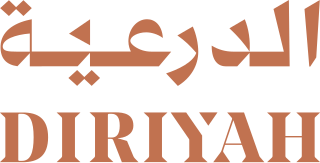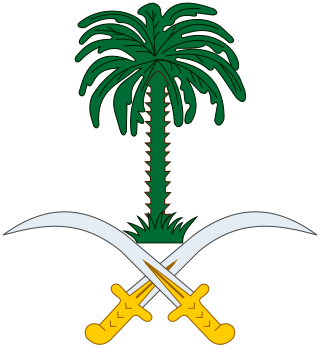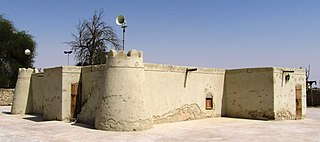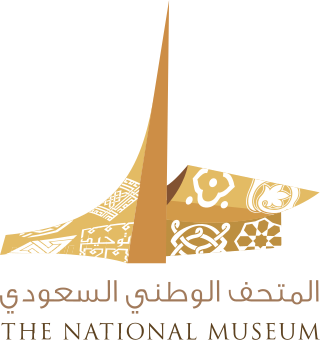Humane Heritage Museum is located in Jeddah, Saudi Arabia. [1] The museum displays many historical pieces from different ancient periods. Such pieces include, cutlery, outfits and weapons. Moreover, a great amount of manuscripts and books can be found. [2]

Riyadh is the capital and largest city of Saudi Arabia. It is also the capital of the Riyadh Province and the centre of the Riyadh Governorate. Located on the eastern bank of Wadi Hanifa, the current form of the metropolis largely emerged in the 1950s as an offshoot of the 18th century walled town following the dismantling of its defensive fortifications.

Jeddah, alternatively transliterated as Jedda, Jiddah or Jidda, is the largest city in Mecca Province, Saudi Arabia, and the country's second largest city after Riyadh, located along the Red Sea coast in the Hejaz region. Jeddah is the commercial center of the country. It is not known when Jeddah was founded, but Jeddah's prominence grew in 647 when the Caliph Uthman made it a travel hub serving Muslim travelers going to the holy city of Mecca for Islamic pilgrimage. Since those times, Jeddah has served as the gateway for millions of pilgrims who have arrived in Saudi Arabia, traditionally by sea and recently by air.

Saudi Arabia, officially the Kingdom of Saudi Arabia (KSA), is a country in West Asia. Located in the centre of the Middle East, it takes up 4/5's or, 40/50 of the Arabian Peninsula and has a land area of about 2,150,000 km2 (830,000 sq mi), making it the fifth-largest country in Asia, the largest in the Middle East, and the 12th-largest in the world. It is bordered by the Red Sea to the west; Jordan, Iraq, and Kuwait to the north; the Persian Gulf, Bahrain, Qatar and the United Arab Emirates to the east; Oman to the southeast; and Yemen to the south. The Gulf of Aqaba in the northwest separates Saudi Arabia from Egypt and Israel. Saudi Arabia is the only country with a coastline along both the Red Sea and the Persian Gulf, and most of its terrain consists of arid desert, lowland, steppe, and mountains. The capital and largest city is Riyadh; other major cities include Jeddah and the two holiest cities in Islam, Mecca and Medina. With a population of almost 32.2 million, Saudi Arabia is the fourth most populous country in the Arab world.

Diriyah, formerly romanized as Dereyeh and Dariyya, is a town and governorate in Saudi Arabia. Located on the northwestern outskirts of the Saudi capital, Riyadh. Diriyah was the original home of the Saudi royal family, and served as the capital of the Emirate of Diriyah under the first Saudi dynasty from 1727 to 1818. Today, the town is the seat of the Diriyah Governorate, which also includes the villages of Uyayna, Jubayla, and Al-Ammariyyah, among others—and is part of Ar Riyad Province.

The Emblem of Saudi Arabia was adopted in 1950. According to the Saudi Basic Law, it consists of two crossed swords with a palm tree in the space above and between the blades.

The Jawatha Mosque, also incorrectly spelled Al-Jawan, is a Sunni Islam mosque, located in the historic Jawatha area, about 12 km northeast of Hofuf, Al-Ahsa, Saudi Arabia. It was the earliest known mosque built in eastern Arabia. Most of the original structure fell into ruins. However, it was restored in 2007 by the Saudi Commission for Tourism and National Heritage, using a design similar to that of Masmak Fort in Riyadh.

Articles related to Saudi Arabia include:

Ushaiqer is a small village near Shaqra in Saudi Arabia. It is 200 km (120 mi) north-west of Riyadh.

Saudi Arabia is the second biggest tourist destination in the Middle East with over 16 million visiting in 2017. Although most tourism in Saudi Arabia still largely involves religious pilgrimages, there is growth in the leisure tourism sector. As the tourism sector has been largely boosted lately, the sector is expected to a significant industry for Saudi Arabia, reducing its dependence on oil revenues. This is proved as tourism sector is expected to generate $25 billion in 2019. Potential tourist areas include the Hijaz and Sarawat Mountains, Red Sea diving and a number of ancient ruins.

Wahbi al-Hariri-Rifai was a Syrian American artist. He was also an accomplished architect, archaeologist, and author. His artwork has garnered international recognition and praise both in his lifetime and posthumously.

The National Museum of Saudi Arabia is a national museum located in the al-Murabba neighborhood of Riyadh, Saudi Arabia. Established in 1999, it is part of the King Abdulaziz Historical Centre and is surrounded by al-Wadi Park to the north and al-Madi Park to the east, who altogether constitute eastern side of the National Museum Park.
Saudi Arabian art is contextual to the country being the birthplace of Islam; it includes both the arts of Bedouin nomads and those of the sedentary peoples of regions such as the Hejaz, Tihamah, Asir and Najd.

The Hejaz Railway Museum in Medina is a railway museum that was opened in 2006. It is on the grounds of the restored historic Ottoman railway station at Medina, locally called استسيون "Istasyōn", including a stretch of the historic track and a train shed with originally four tracks. There are several engines and pieces of rolling stock on display, some of which were transported to the museum from other places along the historic Hejaz railway line. At least one engine has been restored enough to be driveable on the museum tracks. It is, along with the old train station at Mada'in Saleh, one of two museums in Saudi Arabia dedicated to the Hejaz railway.

King Abdulaziz Public Library (KAPL) (Arabic: مكتبة الملك عبد العزيز العامة) is a public library in Riyadh, Saudi Arabia. Established in 1985 by Crown Prince Abdullah bin Abdulaziz, it was inaugurated in February 1988 and assumed its current name in 1996.

The Embassy of Saudi Arabia in London is the diplomatic mission of Saudi Arabia in the United Kingdom. Saudi Arabia also maintains a Defence Attaché's Office at 26 Queen's Gate, South Kensington, a Diplomatic Office of the Cultural Bureau at 630 Chiswick High Road, Gunnersbury, a Medical Section at 60 Queen Anne Street, Marylebone, a Commercial Section at 15/16 Queen Street, Mayfair, an Islamic Affairs Section at 2nd Floor, Park Lorne, 111 Park Road, Lisson Grove, and an Information Section at 18 Seymour Street, Marylebone.

Rijal Almaa or Rijal Almaʽa is a village located in the Rijal Almaa province, 'Asir Region, Saudi Arabia. It is about 50 km (31 mi) west of Abha, in the southwest of Saudi Arabia. The village is more than 900 years old. The village had an ideal location through which it linked the people coming from Yemen and the Levant through the Holy City of Makkah and Medina. As a result, it became a regional trade center.

At-Turaif is a historic district located in Ad-Dir'iyah, north-west of Riyadh. It is regarded as one of the more important political and historical sites in Saudi Arabia, as it represented the capital of Saudi dynasty. It was the original home of the Saudi royal family and was the country's first capital from 1727 until Ottoman control of the area in 1818.

The Ministry of Tourism, before 2020 as the Saudi Commission for Tourism and National Heritage (SCTH), until 2015 as the Saudi Commission for Tourism and Antiquities (SCTA) and prior to 2008 as the Supreme Commission for Tourism (SCT), is a government ministry in Saudi Arabia that is concerned with the tourism sector of the country. Established in the year 2000 through a royal decree by King Fahd, it was transformed into a ministry in 2020.
Below are Museums in Riyadh. The Riyadh region in Saudi Arabia is characterized by having a massive number of historical and heritage monuments and museums, which represent the successive civilizations that left these traces on the area.